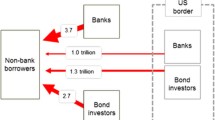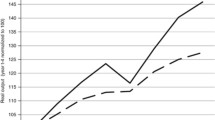Abstract
Policymakers in emerging markets complained that the unconventional US monetary policy response to the Great Recession hurt their economies. US policymakers responded that the policy was geared toward conditions in the US, and that a strong US economy benefited everyone. Here we evaluate these claims in a two country model of the US and an emerging market country, bombarded by shocks to the net worth of US banks. Our model allows us to calculate a “passive equilibrium” in which US monetary policy does not respond to the shock in any way. Then, we calculate a “self oriented” equilibrium in which quantitative easing is set optimally to maximize US welfare, and a “cooperative” equilibrium in which quantitative easing and the monetary policy in the emerging market country are set to maximize joint welfare. Comparing welfare in these equilibria, we find that the self oriented US monetary policy benefits both countries, and that cooperation brings little further improvements in welfare.





Similar content being viewed by others
Notes
As reported in the Wall Street Journal, “Rebuttal for Rajan: Bernanke Defends U.S. Policy,” Apr 15, 2014.
For example, in September of 2010, Guido Mantega, Brazil’s finance minister, accused the Fed of starting a currency war. See, The Economist, Jun 22nd, 2019.
Our model does not capture all of the interactions that Rajan and Bernanke discussed. Other models, focusing on different features, may come to different conclusions.
Canzoneri et al. (2018) show that there is also a forward guidance puzzle for fiscal policy.
Again, we note that standard New-Keynesian models can not explore this policy; the U.S. interest rate would have to be guided by a Taylor Rule, or some ad-hoc terminal condition would have to be imposed.
Rajan did not actually call for full cooperation in this sense.
Bank reserves are the only “base money” asset we have in the model, hence the symbol \(m_{t}^{us}.\) It will be seen however that bank deposits have transactions value.
The functional form used in our numerical calculations is given in the Appendix A.
A large fraction of international trade is invoiced in dollars, and importers utilize dollar transactions balances.
Banerjee et al. (2016), for example, consider a shock to the Taylor Rule in a model that is otherwise similar to ours.
Gertler and Karadi (2011) use a five percent decline in capital quality to describe the Great Recession. We are calculating linear approximations around the steady state, so we settled for a two standard deviation shock.
References
Aoki K, Benigno G, Kiyotaki N (2018) Monetary and financial policies in emerging markets
Backus D, Kehoe P, Kydland F (1994) Dynamics of the trade balance and the terms of trade: the j-curve? Amer Econ Rev 84:84–103
Banerjee R, Devereux MB, Lombardo G (2016) Self-oriented monetary policy, global financial markets and excess volatility of international capital flows. J Int Money Finance 68:275–297
Bannister G, Gardberg M, Turunen J (2018) Dollarization and financial development. IMF Working Paper, WP/18/200
Begenau J (2020) Capital requirements, risk choice, and liquidity provision in a business-cycle model. J Financ Econ 136:355–378. URL: https://doi.org/http://www.sciencedirect.com/science/article/pii/S0304405X19302508, https://doi.org/10.1016/j.jfineco.2019.10.004
Bernanke BS (2015) Monetary policy in the future. Remarks at the IMF Conference, Rethinking Macro Policy III
Bodenstein M, Guerrieri L, LaBriola J (2019) Macroeconomic policy games. J Monetary Econ 101:64–81
Canzoneri M, Cumby R, Diba B (2017) Should the federal reserve pay competitive interest on reserves? J Money Credit Bank 49:663–693
Canzoneri M, Cao D, Cumby R, Diba B, Luo W (2018) The forward fiscal guidance puzzle and a resolution. J Econ Dyn Control 89:26–46. http://www.sciencedirect.com/science/article/pii/S0165188918300137, https://doi.org/10.1016/j.jedc.2018.01.013. fed St. Louis-JEDC-SCG-SNB-UniBern Conference, titled: ”Fiscal and Monetary Policies”
Christiano LJ, Eichenbaum M, Evans CL (2005) Nominal rigidities and the dynamic effects of a shock to monetary policy. J Polit Econ 113:1–45
Curdia V, Woodford M (2011) The central-bank balance sheet as an instrument of monetary policy. J Monetary Econ 58:54–79
Dalgic HC (2019) Financial dollarization in emerging markets: An insurance arrangement. University of Mannheim
Del Negro M, Giannoni M, Patterson C (2015) The forward guidance puzzle. Federal Reserve Bank of New York Staff Report No. 574
Diba B, Loisel O (2021) Pegging the interest rate on bank reserves: A resolution of new keynesian puzzles and paradoxes. Journal of Monetary Economics (forthcoming)
Gertler M, Karadi P (2011) A model of unconventional monetary policy. J Monetary Econ 58:17–34
Gertler M, Kiyotaki N, Queralto A (2012) Financial crises, bank risk exposure and government financial policy. J Monetary Econ 59:S17–S34
Rajan R (2014) Competitive monetary easing: is it yesterday once more? Reserve Bank of India
Tobin J (1977) How dead is Keynes? Econ Inquiry 15:459–468
Author information
Authors and Affiliations
Corresponding author
Additional information
Publisher’s Note
Springer Nature remains neutral with regard to jurisdictional claims in published maps and institutional affiliations.
We thank Luca Guerrieri for helpful discussions.
Appendices
Appendix A:: Monetary Policy, Terms of Trade and Real Exchange Rate, and Market Clearing
A.1 Monetary Policy
In the US, the central bank has two independent monetary policy instruments: the net nominal interest rate on reserves \(i_{t}^{us}\geq 0\), and the stock of nominal reserves \(M_{t}^{us}>0\). In the absence of government bonds, the central bank injects reserves via lump-sum transfers \(T_{t}^{us}\). The nominal stock of reserves thus evolves according to
In the EM, the central bank sets the net nominal interest rate on bank deposit \(i_{b,t}^{em}\geq 0\) by following an inflation-targeting Taylor rule with interest-rate smoothing
where \(\bar {i}_{b}^{em}\) is the steady state net nominal interest rate, and \({\Pi }_{t}^{em}\equiv \mathit {\frac {\mathcal {P}_{t}^{em}}{\mathcal {P}_{t-1}^{em}}}\) is the gross inflation rate of the consumption good.
A.2 Terms of Trade and Real Exchange Rate
We assume that both US and EM final goods are sold in international markets and the law of one price holds. Let \(NOM_{t}^{em}\) denote the EM’s nominal exchange rate, defined as the EM price of the US dollar. Then the law of one price implies
where \(P_{h,t}^{em}\) is the EM price of the home good (the EM good), \(P_{f,t}^{us}\) is the US price of the foreign good (the EM good), \(P_{f,t}^{em}\) is the EM price of the foreign good (the US good), and \(P_{h,t}^{us}\) is the US price of the home good (the US good).
Let \(TOT_{t}^{em}\equiv \frac {P_{f,t}^{em}}{P_{h,t}^{em}}\) be the EM’s terms of trade (analogously, \(TOT_{t}^{us}\equiv \frac {P_{f,t}^{us}}{P_{h,t}^{us}}\) is the US’s terms of trade). Then we have
Given the definitions of
and
we obtain
where \({\Pi }_{t}^{em}=\frac {\mathcal {P}_{t}^{em}}{\mathcal {P}_{t-1}^{em}}\), \(\pi _{t}^{em}=\frac {P_{h,t}^{em}}{P_{h,t-1}^{em}}\), \({\Pi }_{t}^{us}=\frac {\mathcal {P}_{t}^{us}}{\mathcal {P}_{t-1}^{us}}\), \(\pi _{t}^{us}=\frac {P_{h,t}^{us}}{P_{h,t-1}^{us}}\), and \(\epsilon _{t}^{em}\equiv \frac {NOM_{t}^{em}\mathcal {P}_{t}^{us}}{\mathcal {P}_{t}^{em}}\) is the EM’s real exchange rate.
A.3 Market Clearing
US Market Clearing –
The final good is divided between consumption, investment, cost of banking, and export. The goods market clearing condition is thus given by
where
The real trade balance is defined as
The reserve market clearing condition is
EM Market Clearing –
The final good is divided between consumption, investment, cost of foreign borrowing, and export. The goods market clearing condition is thus given by
where
The real trade balance is
The real current account is given by
The balance of payments implies that the real current account equals net foreign capital outflow
Appendix B: The Banker’s Optimization Problem
US Banker’s Problem –
Given that bankers pay dividends to their household only when they exit, a banker j in period t maximizes the expected discounted value of its terminal dividends. Switching to the recursive formulation for the franchise value of bank j at the end of period t, the banker’s problem can be written as
subject to the balance sheet condition and the capital requirement
where the functional form of the bank’s cost of making loans is given by
with \(\kappa _{m}^{us},\varsigma _{m}^{us}>0\). To solve this problem, we first guess that the value function is linear in net worth as
Then we can write the value function (29) as
Using the definitions of leverage multiple \(\phi _{jt}^{us}=\frac {q_{t}^{us}K_{jt}^{us}+l_{jt}^{em}}{n_{jt}^{us}}\), ratio of loans made to EM banks to net worth \(\phi _{ljt}^{us}=\frac {l_{jt}^{em}}{n_{jt}^{us}}\), and ratio of reserves to bank assets \(x_{jt}^{us}=\frac {m_{jt}^{us}}{q_{t}^{us}K_{jt}^{us}+l_{jt}^{em}}\), and the balance sheet condition (30) and (31), we have
Then the banker’s problem can be rewritten as
subject to
where
Let \(\lambda _{cjt}^{us}\) be the Lagrangian multiplier for the capital requirement (32). Then using the Lagrangian
The first order conditions with respect to \(\left \{ \phi _{jt}^{us}, \phi _{ljt}^{us}, x_{jt}^{us}\right \} \) imply
From Eq. 34, we can determine the ratio of reserves to assets of the bank as
Combining (33) and (34) yields
Given that \(\mu _{t}^{us},\mu _{mt}^{us}\) and \(\upsilon _{t}^{us}\) are not bank-specific, Eqs. 35 and 36 imply that \(x_{jt}^{us}=x_{t}^{us}\) and \(\lambda _{cjt}^{us}=\lambda _{ct}^{us}\). When the capital requirement is binding, we have
This implies that the leverage multiple \(\phi _{jt}^{us}=\phi _{t}^{us}\) is common across banks. Accordingly, the aggregate assets in banking sector can be expressed in terms of the aggregate net worth
An equation of motion for the aggregate net worth \(n_{t}^{us}\) is the sum of the net worth of existing bankers \(n_{et}^{us}\), and the net worth of entering bankers \(n_{nt}^{us}\)
The net worth of existing bankers equals the earnings on assets and reserves held last period net the costs of liabilities, multiplied by the fraction of bankers that survive until present period σus
The household transfers to each new banker, a fraction \(\frac {\xi ^{us}}{\left (1-\sigma ^{us}\right )}\) of the assets and reserves of exiting bankers in present period, \(\left (1-\sigma ^{us}\right )\left (R_{k,t}^{us}q_{t-1}^{us}K_{t-1}^{us}+R_{l,t}^{us}l_{t-1}^{em}+R_{m,t}^{us}m_{t-1}^{us}\right )\). The aggregate net worth of entering bankers is thus as follows
The aggregate net worth of bankers is then given by
EM Banker’s Problem –
In the EM, a banker j’s optimization problem is given by
subject to the balance sheet condition and the incentive compatibility constraint
where
To solve the problem, we first guess that the value function is linear in bank net worth as
Using the definition of leverage multiple \(\phi _{jt}^{em}=\frac {q_{t}^{em}K_{jt}^{em}}{n_{jt}^{em}}\) and the balance sheet condition (37) and (38), we can rewrite the banker’s problem as
subject to
where
Let \(\lambda _{cjt}^{em}\) be the Lagrangian multiplier for the incentive compatibility constraint (40). Then using the Lagrangian
The first order conditions with respect to \(\left \{ \phi _{jt}^{em},x_{jt}\right \} \) imply
Combining (41) and (42) yields
Given that \(\mu _{t}^{em},\mu _{lt}^{em}\) and \(\upsilon _{t}^{em}\) are not bank-specific, xjt = xt. When the incentive constraint is binding, from Eqs. 39 and 40, we have
These imply that \(\phi _{jt}^{em}=\phi _{t}^{em}\). Accordingly,
Analogous to the US banks, an equation of motion for the aggregate net worth is the sum of the net worth of existing bankers \(n_{et}^{em}\), and the net worth of entering bankers \(n_{nt}^{em}\)
The net worth of existing bankers equals the earnings on assets held in last period net the costs of liabilities, multiplied by σem
The net worth of entering bankers is a fraction \(\frac {\xi ^{em}}{\left (1-\sigma ^{em}\right )}\) of the assets of exiting bankers in present period, \(\left (1-\sigma ^{em}\right )\left (R_{k,t}^{em}q_{t-1}^{em}K_{t-1}^{em}\right )\). Thus,
The aggregate net worth is then given by
Rights and permissions
About this article
Cite this article
Canzoneri, M., Cumby, R., Diba, B. et al. Did the Unconventional Monetary Policy of the U.S. Hurt Emerging Markets?. Open Econ Rev 32, 231–257 (2021). https://doi.org/10.1007/s11079-021-09616-8
Accepted:
Published:
Issue Date:
DOI: https://doi.org/10.1007/s11079-021-09616-8




